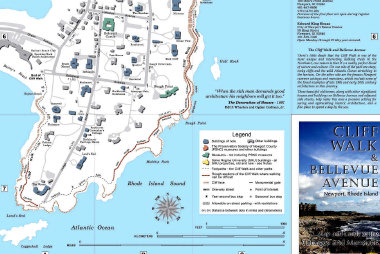Architecture Here and There
9:51 AM Thu, Sep 10, 2009 | Permalink
IT TOOK a guy named Cliff to do the Cliff Walk proud. Cliff Vanover, of Charlestown, has created a new map of the famous segment of Newport south of Memorial Boulevard. The map “Cliff Walk & Bellevue Avenue” harks back to an era when cartography was still an art form.
You could walk the Cliff Walk’s 3 1/2-mile length without learning a hundredth of what you could discover on Vanover’s map, which is really a book arrayed cartographically and described textually, foot by foot — in short, a travel guide on steroids. This part of the City by the Sea has no rival in America for architectural splendor, and few rivals for natural drama. Together, the cliffs on the one hand and the mansions on the other are naturally famous. With Vanover’s guide in hand, one may transform this granddaddy of tourist attractions into a magical day or even a week of encyclopaedic enchantment.
Each of the map’s buildings is not only shown in something resembling its actual form; it also throws a shadow upon the ground. On this map, to judge by its shadows, the weather is sunny and the hour is 2 o’clock in the afternoon — high time, after a long walk, for a bite to eat. Sit down and eat a sandwich, with the map spread before you. Examine it. Whether you’ve chosen a table at a café or a bench along the Cliff Walk, you are doubtless sitting in the midst of a work of art — natural, architectural or both. Lo and behold, you are looking at one,too.
For example, speaking of art, trace a finger along the Cliff Walk until you reach the only building on the seaward side of the path. It is an artist’s studio, described in note No. 28 as: “Whitney Artist Studio- (1939)-International style-Noel & Miller, architects-Gertrude Vanderbilt Whitney was the founder of the Whitney Art Museum in NYC and a great granddaughter of Commodore Cornelius Vanderbilt. She had a Shingle style artist studio built here for herself sometime in the early 1900’s. Destroyed in the Hurricane of 1938, this more modern style of building was erected in its place.-Private residence-5C.”
Pathos aplenty resides in that note. The notes are written in a clipped style, their points of information demarcated with hyphens. The result has the terseness of Hemingway, but in this case it moistened my eye. A lovely old studio wiped away by a storm! And replaced by one in the “International style,” of predictable artlessness! Go take a look at it. Arrgh! A crime of nature was followed by a crime of art. (The sadness of this sequence is emphasized by a “crime” of grammar: one of the most entertaining dangling modifiers I have ever had the pleasure to meet.)
Such morality plays are among the frequent treasures embedded in the details dug up for Vanover’s 154 notes on the notable “cottages” and other structures and landmarks. Some are more sparse, such as No. 57, about a residence with the curious name of: “Weetamoe-G. T. Brayman House-(1872)-Queen Anne style-2 Rovensky Ave-Private residence-6B.” Others are lengthier, such as No. 116, about the Vinland Hen Keeper’s Cottage, which is no more an actual cottage than are the usual sumptuous “cottages” erected by the tycoons of the Gilded Age. “This building,” the note contends, “is probably the finest chicken coop ever built.” No. 27, shorter by one line, declares that Rosecliff is “considered to be the most perfectly proportioned house in Newport.”
A quotation above the map’s legend is from The Decoration of Houses (1897), by Edith Wharton and Ogden Codman Jr. It is most delightful and appropriate. It reads: “When the rich man demands good architecture, his neighbors will get it, too.”
Like architecture and too many other endeavors, mapmaking is a fallen art form. God is in the details, they used to say, but it might as well be the devil for all they’ve been purged by cartographers today. The twin scourge of ineptitude and pretentiousness has assassinated the modern map. Nowadays, you are lucky if the street you seek has not been swallowed up by the mapmaker’s urge to transform a map into a work of abstract impressionism. If you do find the street, it has probably been misspelled. This decline commenced long before Google Maps and has not been rescued by its inartfully cluttered satellite photography. The meticulous assembly of details in the maps of yore created genuine beauty. Cliff Vanover’s map recaptures the joy of cartography.
In its notes and especially on the map itself are an abundance of practical information for those visiting Newport. Parking rules, distance between points, the surface quality of the Cliff Walk, and lots more, not to mention the rare exactitude of its cartographical aesthetic, are priceless aspects of a map, newly published by the Great Swamp Press in the village of Carolina, that sells for a mere $6.95.
David Brussat is a former member of The Journal’s editorial board. His blog is called Architecture Here and There.
Illustration: From front side of Newport map “Cliff Walk &
Bellevue Avenue,” by Cliff Vanover. Courtesy of Great Swamp Press.

